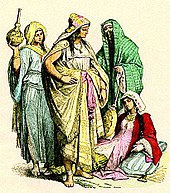Sources of influence
The patriarchal character of pre-Islamic Arabic culture influenced not only the content of the Qur'an and related doctrine, it persists today in the interpretation and application of Islamic dogma. Theological scholarship and practices vary widely according to the country, region, or sectarian beliefs where an Islamic community is located. The largest groups of Muslim women are in: Indonesia (over 100 million), Bangladesh (over 75 million), Pakistan (over 85 million), India (over 80 million), Egypt (nearly 40 million), Nigeria (nearly 40 million), Turkey (over 35 million) and Iran (over 35 million). These countries total more than 60% of the world's Muslims; there are more than 750 million Muslim women worldwide, including sizable minorities in several countries of Africa and Europe, and in China.[12]
Islamic doctrine is the product of Qur'anic guidelines, as understood by Islamic jurisprudence (fiqh), as well as of the interpretations derived from the traditions of the Islamic Prophet Muhammad (hadith), that were agreed upon by majority of Sunni Muslim scholars as authentic beyond doubt based on the science of hadith.[2][13]
The Sunni Muslims are the largest Islamic sect, comprising approximately 80% of the world's Muslims. The Sunni sect includes many theological schools and doctrines interpreting the Qur'an. To Sunni Muslims, the hadith constitutes an important source of legislation. The fiqh is the basis of jurisprudence, or legal practise, developed by Muslim jurists during the centuries following the creation of Islam, and largely influenced by the hadith.[14] These interpretations and their application were shaped by the historical context of the Muslim world at the time they were written.[2] Many of the earliest writings were from a time of tribal warfare which could have been inappropriate for the 21st century, but most remain appropriate to how a Muslim following the sunnah should behave.

Under Islamic law, marriage was no longer viewed as a "status" but rather as a "contract", in which the woman's consent was imperative.[17][18][19] "Women were given inheritance rights in a patriarchal society that had previously restricted inheritance to male relatives/ family members."[17] Annemarie Schimmel states that "compared to the pre-Islamic position of women, Islamic legislation meant an enormous progress; the woman has the right, at least according to the letter of the law, to administer the wealth she has brought into the family or has earned by her own work."[20]
William Montgomery Watt states that Muhammad, in the historical context of his time, can be seen as a figure who promoted women’s rights and improved things considerably. Watt explains: "At the time Islam began, the conditions of women were terrible - they had no right to own property, were supposed to be the property of the man, and if the man died everything went to his sons." Muhammad, however, by, "instituting rights of property ownership, inheritance, education and divorce, gave women certain basic safeguards."[21]
During his life Muhammad married eleven or thirteen women depending upon the differing accounts of who were his wives. In Arabian culture, marriage was generally contracted in accordance with the larger needs of the tribe and was based on the need to form alliances within the tribe and with other tribes. Virginity at the time of marriage was emphasized as a tribal honor.[22] Watt states that all of Muhammad's marriages had the political aspect of strengthening friendly relationships and were based on the Arabian custom.[23] Esposito points out that some of Muhammad's marriages were aimed at providing a livelihood for widows.[24] Francis Edwards Peters says that it is hard to make generalizations about Muhammad's marriages: many of them were political, some compassionate, and some perhaps affairs of the heart.[25]













 00.55
00.55
 muslimdress
muslimdress

 Posted in:
Posted in: 



